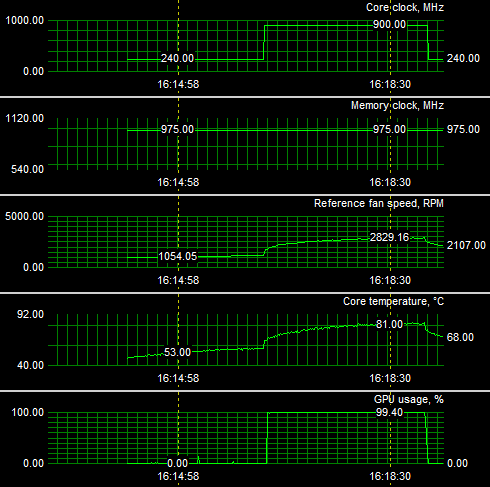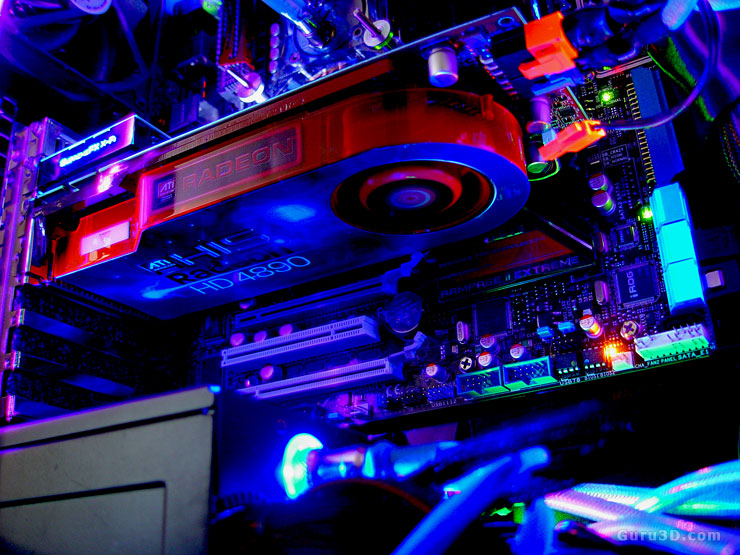Setup | Noise | Power consumption | Heat levels
Installation
It's the standard anno 2009. Graphics cards are pretty easy to install. This card was no different. Slide the card into a free PCIe 8x / 16x slot and connect a monitor. Connect the two 6-pin PCIe power cables (it is required to connect them both).
You can now power up the PC. Once Windows boots up, install the latest Catalyst drivers and make sure your operating system is fully patched up, especially DirectX. After driver installation, reboot the PC and you are ready to go to play games and move into your fragging spree.
Of course the card is also CrossfireX compatible. If you like to pursue it, place two or three of these cards on a Crossfire supported motherboard, bridge the graphics cards width the supplied connectors and after driver installation make sure that CrossfireX is enabled in the ATI Catalyst control center. Oh and hey... keep your power supply specifications up to par. Each added 4890 card means another 190 Watt (peak) on your 12 Volt rails. 190/12= 16 Amps per graphics card.

Power consumption
It's time to do some actual testing with these cards. We'll start off by showing you some tests we have done on overall power consumption of the PC. Looking at it from a performance versus wattage point of view, the power consumption is pretty good with the new 55nm products.
Though the Radeon HD 4890 can peak roughly 30 Watts higher during your game sessions (opposed to 4870), in IDLE (desktop mode) it has become more energy efficient though.
The test: we recently upgraded our test-platform, which by itself utilizes a lot of energy.
It's Core i7 965 / X58 based and overclocked to 3.7 GHz. Next to that we have energy saving functions disabled for this motherboard and processor (to ensure consistent benchmark results). The ASUS motherboard also allows adding power phases for stability, which we enabled as well. I'd say on average we are using roughly 70~100 Watts more than a standard PC due to these settings + CPU overclock. Keep that in mind.
- System in IDLE = 223 Watt
- System with GPU in FULL Stress = 370 Watt
On an average system we feel that a single Radeon 4890 series requires you to have a 550 Watt power supply unit at minimum if you use it in a high-end system, and I feel that's a little on the safe side. Also recommended is a total of 32 AMPs on the +12 volt rails for stable power distribution (in a single card configuration).
Crossfire is something else, you add another 190 Watts. I recommend a PSU of, at the very least, 750-800 Watts. Make sure you have some reserves folks. It's not that your PC will consume that much power, it's just that you want to make sure your PSU can deal with the hefty load and will stay stable during your entire gaming experience.
With three cards (CrossfireX) obviously 800+ Watt power supplies are recommended, and in fact even needed to be able to supply something as simple as enough PCIe graphics power connectors.
There are many good PSUs available, over the years we reviewed a lot of them and have loads of recommended PSUs for you to check out in there, have a look. Things that can happen if your PSU can't cope with the load?:
- bad 3D performance
- crashing games
- spontaneous reset or imminent shutdown of the PC
- freezes during gameplay
- PSU overload can cause it to break down
The thermal envelope
We measure at a room temperature of 21-22 Degrees C, look at idle temperature and then load the GPU 100% for a couple of minutes and measure the temperature once a second and follow the temperature delta.
Typically the standard Radeon 4890 products come with a bit of an average cooler. Temperatures can rise up to 90 Degrees C on these products. Which is considered normal these days.
For the 4890 the results are like so:
- the GPU idles at a temperature of roughly ~50 Degrees C
- the GPU stressed maxes out at roughly ~80 Degrees C

Now we had to customize Rivatuner a little to get the new card going. But it'll work flawlessly. In the previous chapter we mentioned the low IDLE power consumption of 60 Watt (well... low, lower I guess). ATI manages to do this with the help of different power states.
So in Idle or low usage status the clock frequency and voltages within the GPU can be lowered to preserve power consumption. We see the card idle at a core clock frequency of 240 MHz. And when used, it jumps to 900 MHz.
Surprisingly enough the memory clock remains untouched.
Noise Levels coming from the graphics card
When graphics cards produce a lot of heat, that heat usually needs to be transported away from the hot core as fast as possible. Often you'll see massive active fan solutions that can indeed get rid of the heat, yet all the fans these days make the PC a noisy son of a gun. The test we do is extremely subjective. To test the noise level we use a certified dBA meter and with it we measure how many dBA originate from the PC. Why is this subjective, you ask? Well, there is always noise in the background, from the streets, from the HD, PSU fan etc etc, so this is by a mile or two not a precise measurement. You could only achieve objective measurement in a sound test chamber.
The human hearing system has different sensitivities at different frequencies. This means that the perception of noise is not at all equal at every frequency. Noise with significant measured levels (in dB) at high or low frequencies will not be as annoying as it would be when its energy is concentrated in the middle frequencies. In other words, the measured noise levels in dB will not reflect the actual human perception of the loudness of the noise. That's why we measure the dBA level. A specific circuit is added to the sound level meter to correct its reading in regard to this concept. This reading is the noise level in dBA. The letter A is added to indicate the correction that was made in the measurement. Frequencies below 1kHz and above 6kHz are attenuated, whereas frequencies between 1kHz and 6kHz are amplified by the A weighting.
| TYPICAL SOUND LEVELS | ||
| Jet takeoff (200 feet) | 120 dBA | |
| Construction Site | 110 dBA | Intolerable |
| Shout (5 feet) | 100 dBA | |
| Heavy truck (50 feet) | 90 dBA | Very noisy |
| Urban street | 80 dBA | |
| Automobile interior | 70 dBA | Noisy |
| Normal conversation (3 feet) | 60 dBA | |
| Office, classroom | 50 dBA | Moderate |
| Living room | 40 dBA | |
| Bedroom at night | 30 dBA | Quiet |
| Broadcast studio | 20 dBA | |
| Rustling leaves | 10 dBA | Barely audible |
We start up a benchmark and leave it running for a while. The fan rotational speed remains constant. We take the dBA meter, move away 75 CM and then aim the device at the active fan on the graphics card.
- In IDLE the cooler can hardly be heard. Roughly 39 dBA
- When the GPU reaches higher temperatures during gaming the fan will start to rotate at roughly 2500 RPM. It creates a lot of airflow, audible airflow. We measured that level at 43~44 dBA. You'll definitely be hearing the card very well, though it's not annoying.
 The Radeon HD 4890 is not a rather silent card though.
The Radeon HD 4890 is not a rather silent card though.
